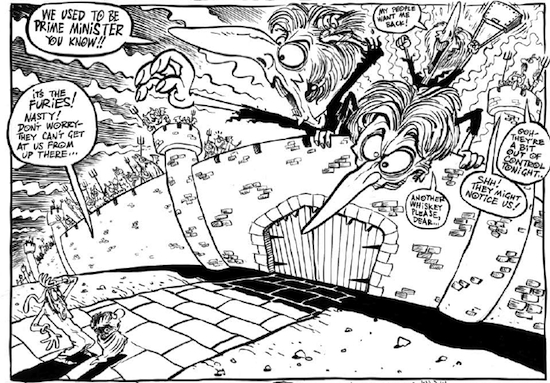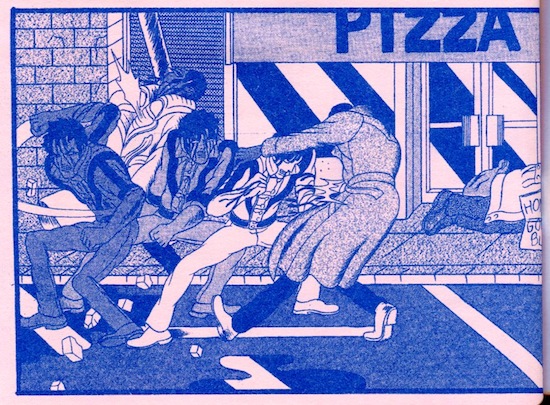Mat Colegate writes:
Reminiscence, the great taste of the past, a trip in The Nostalginator. As if this columns’ manifold references to early-90s video gaming weren’t enough, an announcement from DC comics has me going all misty eyed and hankering for the dusky brown colour schemes and half-glimpsed lady nipples of my youth. Karen Berger, the editor of DC’s ‘mature readers’ offshoot company Vertigo, is stepping down after nearly twenty years. Twenty years! Weep with me baffled reader as I wake up to just how long I’ve owned that knackered copy of Black Orchid. As I realise and hanker after the hot and beautiful things I could have done with my life if I hadn’t insisted on re-reading The Invisibles all those times. Berger is one of the folk responsible for the sudden appearance of skip loads of Brit writers and artists in American foldy-books in the early 90s. Peter Milligan, Grant Morrison, Neal Gaiman, Jamie Delano, and Garth Ennis are just some of the names she herded, drunken and hooting, into the US comics aristocracy. That’s a damn impressive list, and when you start to think of some of the titles she oversaw, the scope of her achievements becomes even wider. Imagine a comicsverse without Sandman, or Hellblazer, or Shade the Changing Man, or Transmetropolitan, or The Filth. You can’t, and why would you want to? Of course, Vertigo had its problems. Its insane reliance on the previously mentioned brown colour schemes for one. Its insistence that anything to do with fairies and the uncharted realms of the imagination was an Angela Carter worthy masterpiece instead of sub-Goth snivelling (I blame Gaiman for that one, to be fair), but at its best it released some outstanding genre books and highlighted some fantastic talents that are still kicking today. Of course, even without these achievements, Berger’s sheer presence at the heavy business end of American comics tells you all you need to know about the current bullshit being spouted by people that should know better re: the subject of ‘Fake Geek Girls’. Those evil Maenads outraging the fan population by, y’know, liking comic books and, y‘know, having tits. Berger put undoubtable passion into supporting the medium she loves and it’s something to think about the next time you see someone sneering at a female con goer for wearing a slinky costume, or not being able to name all the original members of the Legion of Superheroes. Without wishing to go into details about the whys and wherefores of her move, this column wishes her every luck in her future endeavours, although it encourages her to leave the brown paints in the box next time.
Negron
(Jonny Negron, pub. Picturebox)
God, but this is a cool looking book. It’s the perfect size – just slightly bigger than your average paperback, but smaller than your big old art tome – and it’s hypercolour cover seems to melt into its surroundings, neonising everything it touches and turning your mouldy book strewn bedroom into a Miami Vice drug lord’s Saturday pad. Indeed when it comes to the slightly spurious concept of cool, Negron is someone who’s got all the spades. Puke-makingly young, lauded to the skies, and super talented, he sits right at the hot end of contemporary American cartooning. I’ve spoken to people who’ve thought that Negron isn’t really a comics artist at all, which I find a little bit baffling, like when people claim that Death Grips aren’t really a hip hop act. It’s not that I disagree, more that I’m not sure what the really is meant to convey. To be honest, on the evidence of this beautifully put together collection, the naysayers may have a point. This isn’t so much a collection of comics as a pin-up book. Mostly presenting the Long Island native’s pictures of alluring, full-bodied hipster girls in a variety of locations and scenes, nearly all of which have hints of the surreal and dangerous. How much you enjoy these pieces depends, I suppose, on one’s inclinations – I’m more a Guido Crepax dude, to be honest – but his work is of a consistently excellent quality and a couple of the stranger pieces are troubling and have a palpable hint of danger to them. Also contained within are a handful of Negron’s fascinatingly non-linear experiments with comics form and all of them are winning trips into the dislocated and disturbed. Indeed, Negron’s ‘Violence City’ may be one of my favourite short comics stories of recent years, blending 1980s retro-stylings, Lynchian dream atmospheres, and the pacing and layout of classic computer games (I dare say the fact that it heavily references 1980s bone-break-a-thon Final Fight* has a fair amount to do with my appreciation) to create something beguiling. A landscape in which violence is certain but its consequence and meaning are never clear. Short, brutal and haunting, ‘Violence City’ points the way to a unique way of telling stories with the form. I’d love to see what would happen were Negron to turn his talents to a longer tale.
*or Streets of Rage, which I know is a better name, but after spending pretty much every last scrap of money I had on the damn coin-op machine in 1991 I thought I’d give the arcade title it’s child-robbing due. So thanks Final Fight, you bastard, you’re why I could never afford to go ice skating.
Krent Able’s Big Book Of Mischief
(Krent Able, pub. Knockabout)
Those of you who are lucky enough to get access to the excellent free music paper The Stool Pigeon will already be familiar with Krent Able’s…I’m sorry I just can’t start this like a normal review: ‘panel layout blah blah blah, character work yadda yadda, influence of Jack kirby etc etc etc’ – this doesn’t work like ordinary comics. This is a picture of a priapic Nick Cave, grinning like a wicked child, clutching a megaphone and riding a saddled monkey. This is Barack Obama set upon and face-fucked by Lady Gaga’s cloned bat-winged vagina, Johnny Cash being greased and forced head first into a psychedelic anus in order to assassinate Hitler, Iggy Pop’s massively distended bollock finding its way onto the faces of pleading children. It’s fucking horrible, I love it, it’s fucking horrible, I love it ad infinitum. To tear my focus away from the actual pages for a second, I would say that the book I’ve read recently that most reminds me of the Big Book Of Mischief was Josh Simmons’ The Furry Trap (which I am going to keep recommending to you all until you all buy a copy). Not in the way it chooses to depict it’s horrors – indeed Simmons’s hideous step-by-step-into-nightmare approach couldn’t be more different from Able’s hurl-the-shit-at-a-popstar-until-everybody-pukes efforts – but in it’s absolute commitment to go as far as it can into the horror it’s depicting. Unflinching and meticulous, Able’s muse can be trusted, and you get the feeling he trusts it himself. If I were to don the serious critic hat and meditate away from the obscenity for a second, I would say that some of his best moments are the quieter ones – the way that Kanye West ‘dum de dums’ as he signs a contract in childishly massive letters, Johnny Cash’s strange mantric insistence on heading down to ‘The Berg’ – little moments that point away from the vile satire. Of course, Able is not a ‘satirist’ in the conventional, toothless sense. I don’t think he could give a flying bat-winged vagina about ridiculing contemporary mores, or placing our obsession with celebrity on a pedestal for all to see. Rather, Able’s work seems to come from a place where rage and hilarity scrap unceasingly, the work emerging as a dry-heaved chuckle. The kind you’d hear from a seen-it-all-before acid dealer turned piss-encrusted tramp. It’s that sense of genuine malice that lurks underneath the book’s surface that gives it it’s disturbing hold.
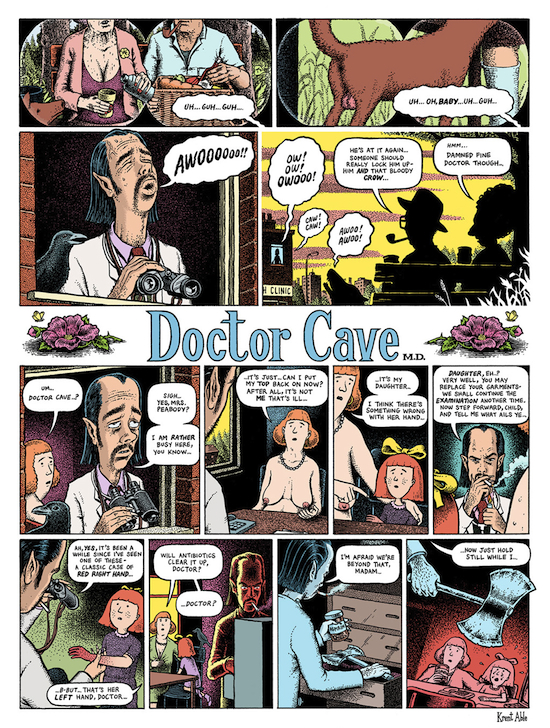
Everything Together
(Sammy Harkham, pub. Picturebox)
My first exposure to Sammy Harkham’s work was through the last edition of American left-field comics anthology Kramers’ Ergot, in which was nestled his short, tar black story ‘A Husband and a Wife’ which managed within 12 pages to swing between surreal humour, dreamlike fantasy and pure grotesquery, and unsettle greatly in the process. The fact that it was one of the undoubted highlights of even that excellent anthology meant that I was looking forward to seeing more of Harkham’s stuff. Turns out this ability to swing between tones is a feature of Harkham’s work and one of its major strengths. My favourite story in the collection ‘Elisha’ tells a tale of loss and resurrection that takes in fart jokes, camels, and family tragedy, and culminates in unsettling body horror and a truly brilliant punch line. Nestled next to this mini masterpiece are short stories that feature Napoleon as a frustrated cartoonist, seafaring adventure, coming of age tales, as well as professional reminiscences. Even my distaste for this last type of story is tempered by Harkham’s art. Man, this guy can draw. Amongst Everything Together’s treasures there’s an eight panel two page spread featuring a sequence of a girl running with a bin on her head that is amongst the most perfect series of pictures I’ve seen this year. It’s so simple and eloquent that it’s almost lyrical and that kind of quality is gripped tightly throughout the book.
Adventures of a Japanese Businessman
(José Domingo, pub. Nobrow Press)
José Domingo was an unknown quantity to me before this book, which has a deceptively simple set up: the salaryman of the title leaves work and a succession of ever escalating and surreal events befall him. Blam. Got it. But where it gets interesting is that nearly all the panels are drawn from the same perspective, the top-down, isometric viewpoint made popular by video games such as Syndicate Wars and Gauntlet. This narrative restriction, at once alien and removed as well as nostalgic and familiar, allows Domingo to swoop through some hilariously full-blooded flights of fancy, incorporating incitements to public nudity, mutagenic chemicals, Leaf eating witches, and baby sacrificing, satanic postal service employees. Every page throws up a fresh peril for our heroic clock-puncher, all rendered in Domingo’s pleasingly chunky eight-bit influenced cartooning. That’s two books I’ve reviewed this week that take computer games as an influence on their layouts and pacing. Some of the biggest influences on the current crop of underground cartoonists seem to be the Megadrive and SNES games of their youths, as well as the more well-trodden Kirby/Eisner-isms of past practitioners. My consumptive pulse races like Wipeout at the thought. Has anyone done a comic based on Outrun yet? You could get some sexual tension out of that one. But you’d have to explain why in the Outrun universe it was possible to total Testarossas by driving them into cacti. I have often wondered.
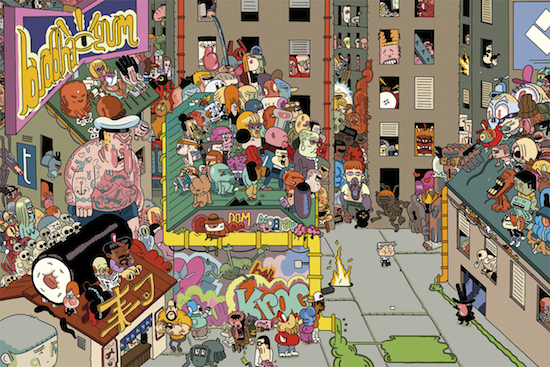
Trip or Squeek’s Big Amplifier
(Savage Pencil, pub. Strange Attractor)
I’ve got to admit to not previously being a fan of Edwin Pouncey (real name of credited furious writing implement)’s Trip or Squeek. Nestled in its usual position at the foot of The Wire’s letters page, it occasionally feels a little smug. A little too pleased with its knowledge of Black Metal, Keiji Haino bootlegs, and fathomless free jazz albums to be much more than an amplification of the bluster above it rather than the satire it sets out to be. However, all this changes when the work is collected and presented as a whole, and its creator’s personal obsessions are allowed to gelatinously conglomerate into an unholy skronk all of their own. Avant Garde music is funny. You know it, I know it, Edwin Pouncey knows it. Did you see that photo in The Wire a couple of months ago with that fella blowing his trumpet into a stack of chairs? Funny. New Scott Walker album? Really fucking funny. Of course this doesn’t impact the power of the music one iota (it heightens it, if anything) but an acknowledgement of the mirth at the heart of the tricky beast is always welcome and that’s what you get with this classy little book. That Pouncey manages to find time to highlight his other obsessions during its course is also welcome. I could look at his Lovecraft-influenced monsters all day and I’m a little ashamed that it was only after reading Gary Panter’s introduction that I started to notice his clear influence on the strip. But what we’re here for are the laughs and, taken as a whole, there’s a lot of them in this noisy, chaotic, and charming collection.
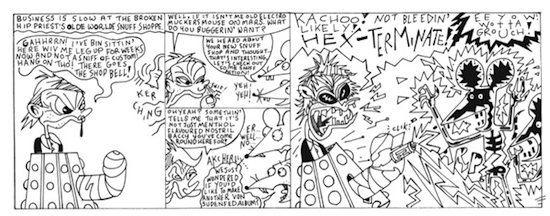
Aug Stone writes:
Drawn Together
(Aline & R. Crumb, pub. Knockabout)
The Collected Works of ‘The World’s Only Cartooning Couple’. Drawn Together brims with life, positively crammed with dialogue and Robert and Aline’s reflections on their own lives and existence itself. From California in the 70’s and 80’s to their relocation to Southern France in 1993, the book also journeys to the Whole Earth Jamboree, Terra II (a spaceship run by Timothy Leary), the Cannes Film Festival, Fashion Week in New York, Minnesota for a Crumb family reunion, and even a trip to Shelton, Connecticut to visit the Better Packages Company who made their ‘Beloved Tape Dispenser’. Such personal preoccupations permeate Drawn Together. But the majority of the book takes place right at home, sorting through the ingredients of everyday life. From their earliest collaborations in 1974 to the present day, the husband and wife team take us through their obsessions (music and record-collecting from Robert, body image with Aline) and sexual peculiarities, good times and grave concerns, with a great sense of fun. Always aware that the reader might not care to see such sides of their, or anyone’s, life. And in showing these details anyway, and also showing their concerns about showing them, one can’t help but be charmed by the Crumbs. A wonderful creation, by turns brooding and bustling, but all the while giving us a very full sense of what draws, and has kept, these two together for 40 years, Drawn Together offers much more than even its considerable bulk suggests.
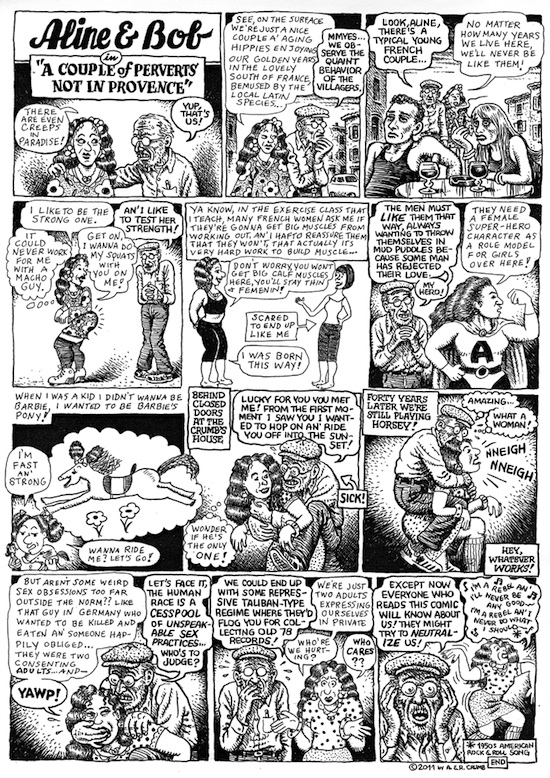
Karl Smith writes:
Journalism
(Joe Sacco, pub. Jonathan Cape)
Joe Sacco’s Journalism is of a peculiar sort. Call it comic-journalism and it sounds like you’re selling it short, as some kind of comedy turn, the same goes for illustrative journalism – the images Sacco produces are decidedly more than scribbles in the margins. That said, of course, they are reportage and – it goes without saying – they are not benign and are, as all journalism is, intended to illustrate one point or another. Perhaps the most accurate term is ‘graphic journalism’, which defines not just the style of Sacco’s reportage but also its content.
The ongoing and recently inflamed Israel-Palestine conflict, the war in Bosnia and Herzegovina and subsequent trials in the Hague all feature in Sacco’s newly-published best of collection. But Journalism is not light work, or comic relief, it is disturbing and it is – above all – graphic: faces, twisted in malice and in pain, somber and awash with vitriol, stare out from its pages in a way that traditional textual journalism cannot capture and even photo-journalism fails to replicate. In recreating not only the situations that he is privy to, but also the stories and backstories that spiral seemingly infinitely outward from those encounters, the frames of Sacco’s book are colourful (in every sense), unconventional and, it could easily be said, they are rather contrived – but they have to be. It’s the nature of Sacco’s art, where thinking about “how” to draw something is doubly as important as knowing what to draw.
Sacco deals head-on in his introduction with the difficulties tied to graphic journalism – the impossibility of the rendering of objective reporting through subjective media and the frivolousness (unfairly) associated with it – it is criticism that he can’t ignore, but which he deals with graciously. Journalism, as representative of Sacco’s body of work, is likely to divide: it is as much hard journalism as it is art, but you have to question whether it is really capable of ever being wholly one or the other.
Reggie Chamberlain-King writes:
Dante’s Inferno
(Hunt Emerson, pub. Knockabout)
Living and breathing in Northern Ireland, I found Hunt Emerson’s Inferno, the first part of a triptychal biography of The Divine Comedy’s Neil Hannon, disappointing. The pulsating mass of sinful sinners is accurate, as is the stench of Satan’s bellowed bumburps; these I remember from my childhood in West Belfast, just as Mr. Hannon knows them from growing up in County Fermanagh. Even the preponderance of Italians is spot-on; an influx of immigrants into the North and East of Belfast in the 19th Century has made several Italianate surnames as commonplace as O’Flibberty and McGillycuddy. However, as a psychological inquiry into the mind of Ulster’s dearest bishopric heir, it falls down. It doesn’t mention the man once.
As an irreverent take on Dante Alighieri’s 14th Century epic poem of the same name, it is more successful. Conscious of what it is and constantly changing the same, it takes pleasure in being unfaithful and, as a result, should wind up in the second circle of that inferno with Dido and Achilles and Francesca da Rimini. It frequently counters itself: making fun of itself, its readers, and its source material. Which is a relief.
Occasionally putting well-hewn English words, from centuries of translation, into the mouth of a cartoon Dante has a charming effect: The Divine Comedy that we know and that he wrote are not the same. It has been subject to hundreds of years of interpretation, reinterpretation, and estrangement from context. Virgil, Dante’s guide through the layers of Hell and our guide through the hellish layers of meaning, doesn’t tire of making this point: – Alighieri is continually pulled up on writing what was, ultimately, a series of personal vendettas in a very idiosyncratic interpretation of the inferno. As a result, this is a very idiosyncratic interpretation of the Inferno.
It is foremost a comic and very barely an epic poem. Dante’s poetry allows for beautiful translation and his imagery allows for beautiful artwork, but Emerson eschews both in favour of tricks that only comics can achieve. There would be no point in doing otherwise: he could hardly top Ciaran Carson’s reworking or Gustav Dore’s illustrations. Instead, the illustrator delights in a vivid Hell populated by the Katzenjammer Kids and Mr. Natural; the tormented weep through wide Bosko smiles. The fourth wall is broken and physical laws are bent and, yet, this brings it back to what Dante had intended originally: the populist, the grimy, the vernacular. In avoiding what is most valuable in The Divine Comedy – the language – Emerson makes invaluable use of its weaker element – the picaresque plot – and, in so doing, creates quite a joyful journey through Hell.
